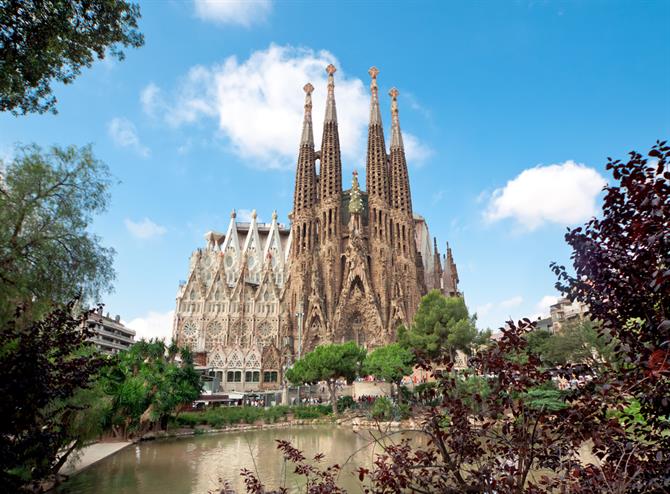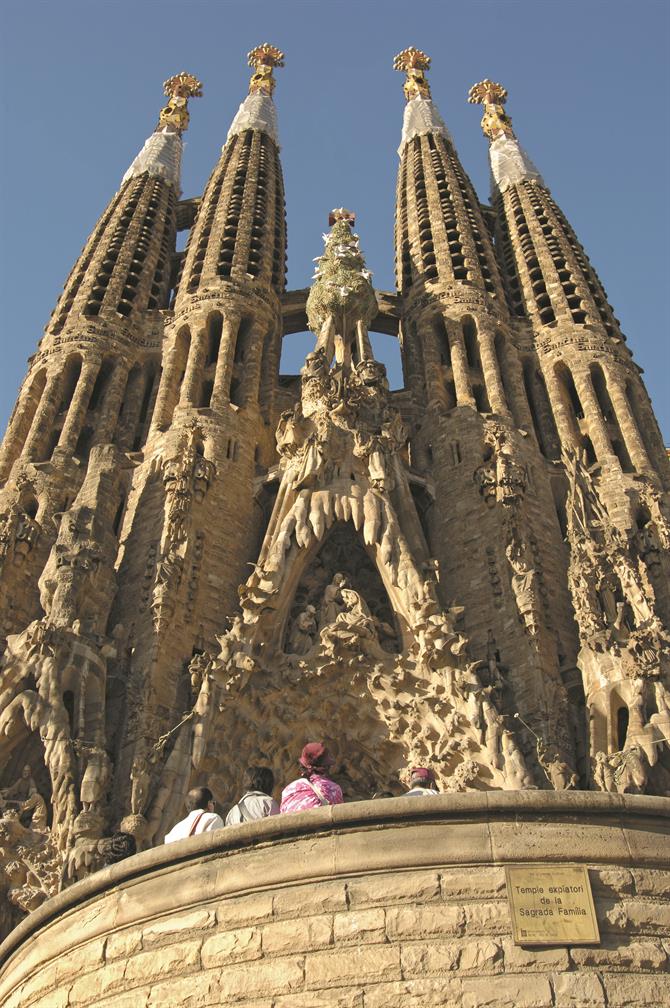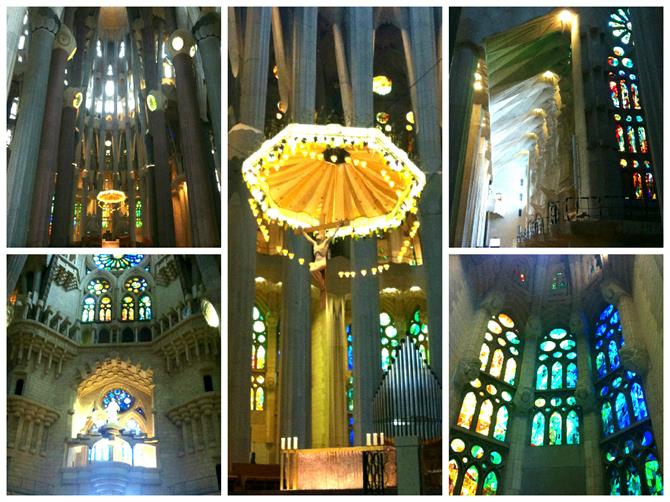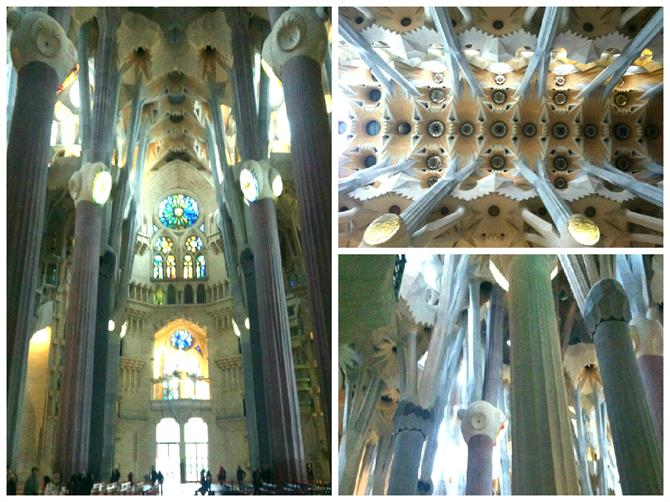If you plan to visit the Catalan capital, the Sagrada Familia should be at the top of your list of things to see and do during your stay in Barcelona. This church will surprise you, not only because of its massive size, but especially because of its avant-garde architecture, which perfectly shows off the genius of its architect, Antoni Gaudí.
Let's go and discover the most visited monument in Spain: the Sagrada Familia!

History of the Sagrada Familia
This monumental basilica is known in Spanish as "el Templo Expiatorio de la Sagrada Familia", which literally translates to the "Expiatory Temple of the Sacred Family". Although the official starting date of work on the basilica is March 19, 1882, construction truly began over a year later on August 25, 1883.
Originally, it was architect Francisco de Paula del Villar who was in charge of the project, which he envisioned in a classic Gothic style. His plans consisted of a three-nave church with elements such as blister windows, exterior buttresses and a high needle-like spire, all typical to Gothic architecture. But eventually, the work was entrusted to Antoni Gaudí in 1883, aged just 31 years old. Gaudí completely changed the original project and began building his most famous work, which marked his style, made him known worldwide, and allowed him to be known as the master of modern architecture.
From the time he took over the project until his death in 1926, Gaudí worked to build this unique temple that was intended to become a universal masterpiece combining all symbols of Christianity.
The Sagrada Familia is an expiatory temple, that is to say, a place made to commemorate the reparation of sins made against God or the laws of the Church. The work is directly financed by donations made by visitors and the public, which explains its slow construction progress. Gaudí even once said "the Expiatory Temple of the Sagrada Familia is made by the people and this is reflected in it. It is a work that is in the hands of God and the will of the people". Construction still continues today and its completion is scheduled for 2026, a date symbolic of the centenary of Antoni Gaudí's death.
Below is a video that explains what the Sagrada Familia should look like once it is finished:
The work
Gaudí was aware that the construction of the Sagrada Familia would last for centuries, which is why he proposed to focus on the front of the church; he wanted the generation that had begun the work to be able to enjoy a form of completion, as well as inspire future generations to continue the construction of a project that had begun before their time.
Gaudí tried to define the Sagrada Familia's construction, but he only completed detailed plans for the three of the most important parts: the central nave, the sacristy and the facade of Glory. These three plans have been used to inspire further construction, including that of other naves and central towers.
- The Nativity Facade
The Nativity facade symbolizes, as its name suggests, the birth of Jesus. Built between 1894 and 1930, it is the only facade to be built almost to completion while Gaudí was alive. Gaudí saw the facade as a representation of nativity, a symbol of life and creation. That is why he introduced its exuberant ornamentation, including animals and tools mixed with symbols, such as the Tree of Life.
Facing the east (north-east to be precise), the facade has three entries that represent the theological virtues: Hope to the left, Faith to the right and Charity at the centre, along with the Door of Jesus and the Tree of Life. The facade culminates with four bell towers dedicated to St. Matthew, St. Jude, St. Simon and St. Barnabas.

- The Passion Facade
Work on the Passion Facade began in 1954 and it was completed in 1976, its construction guided by drawings made by Gaudí. Decorative work was carried out after its initial completion.
As its name suggests, this facade is dedicated to the Passion of Christ, which explains its simplicity, unadorned and with bare stone.
Gaudí described his design of the Passion Facade as follows: "Some will find this door too extravagant; I wanted it to impose fear. To achieve this, I did not avoid shadows, motifs coming in and out, and everything to gain a dark effect. I am ready to sacrifice this construction, to cut the columns to give an idea of the cruelty of sacrifice."
- The Facade of Glory
The Facade of Glory will be the largest and most important of the three facades, because it is the one that will give access to the basilica's central nave. Work on this facade began in 2002 and it is therefore not very far along.
This facade is dedicated to the heavenly glory of Jesus and represents his rise to heaven. Knowing that he would not see the beginning of this facade in his lifetime, Gaudí drew only a few sketches showing his general ideas and plans: representations of Death, Final Judgment, and Glory, as well as Hell for anyone that deviates from God's path.
The bell towers that remain to be built will be dedicated to St. Andrew, St. Peter, St. Paul and Jacques d'Alpheus.
- The interior
Although the outside of the Sagrada Familia is a work of art in itself, we must not forget to mention its interior. For those who have the opportunity to visit, the interior is surprising due to its magnitude, light and decor, and because this incredible monument is far outside the norm. Furthermore, as with the exterior, the interior has great religious and symbolic significance, based on the Gospels and the book of the Apocalypse.

The interior of the Sagrada Familia is also strongly marked by Gaudí's personal style and inspired by nature. To avoid the use of Gothic buttresses, he created columns shaped like tree trunks, giving the feeling of being in a forest rather than inside a church.
The ground plan of the Sagrada Familia is made up of a classic Latin cross comprising a nave of five ships (nave flanked by double collateral sides) opening onto a transept with three naves, and an apse with a large ambulatory. It opens onto seven chapels and two spiral staircases, which give access to choirs that surround the apse.
The five central naves measure 90 metres long and 60 metres transept. The central nave has a width of 15 metres and 7.5 metres collateral, giving it a total of 45 metres wide. Regarding the transept, the width of the cross is 15 meters.
With regard to the arches, they have a unique shape made up of perforated keystones to allow for the arrival of natural heat. The keystones that cover the central nave of the temple were completed in 1993. At the central nave, the height of the arch is 45 metres by 30 meters. As for the height of the apse vault, it reaches 75 metres high.

The Sagrada Familia in numbers
- 14,000 people can fit inside the Sagrada Familia
- 4500 m²
- 170 metre high central tower dedicated to Jesus (the tallest religious building in the world)
- 12 bells to represent the 12 apostles of Jesus
- 120 metres long and 90 metres wide, the size of a football field
- More than 2.5 million visitors a year
Practical information
The Sagrada Familia is open:
- November to February from 9:00-18:00
- April to September from 9:00-20:00
- October to March from 9:00-19:00
- On 25 and 26 December and 1 and 6 January from 9:00-14:00
Ticket sales stop 15 minutes before closing time
There are several tour prices:
- Sagrada Familia with a guide: €19.50
- Sagrada Familia with a guide and tower visit: €24
- Sagrada Familia with an audio guide: €19.50
- Sagrada Familia and tower visit with an audio guide: €24
- Sagrada Familia and tower visit: €19.50
- Sagrada Familia and Gaudi House Museum (Park Güell): €18.50
- Sagrada Familia visit: €15
- Gaudi House Museum (Park Güell): €5.50
Admission is free for the friends of the church, children under 10, persons with an accredited disability of 65% or higher with an attendant.
The Sagrada Familia is the most visited monument in Spain and it is strongly recommended that you buy your tickets online before your trip to avoid long queues.
How to get there
La Sagrada Familia is located in the centre of Barcelona, with the street address Carrer de Mallorca 401 (N 41º 24 '283 "| E 2º 10' 486").
It is possible to get there using public transport:
- Metro: L5 and L2, Sagrada Familia station
- Bus: 19, 33, 34, 43, 44, 50, 51, B20 and B24.
Additional information
Here are other travel articles about Barcelona that could interest you and help you prepare for your stay in this beautiful city.
- Cheap Eats in Barcelona: tips for eating cheaply in Barcelona
- 48 Hours in Barcelona: what to see and do in Barcelona over a weekend
- The Ultimate Gaudí Guide: a guide to known and unknown Gaudí buildings in Barcelona
- Barcelona city guide: Gràcia, an independent 'city': visiting Barcelona's Gràcia district
- Barcelona's Palo Alto Market caught on Instagram: things to do at Barcelona's hipster market
- BYOB: Bring your own bike (into Barcelona's bike-friendly bars): a guide to bike-friendly bars, cafés and restaurants in Barcelona
- The genius of Gaudí: Casa Batlló, Barcelona: a Barcelona must-visit, Gaudí's Casa Batlló
- Everything you need to know about Gaudí's Park Güell in Barcelona: the title says it all
